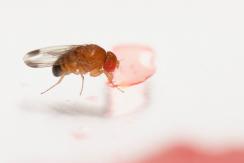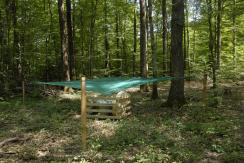Evolutionary Ecology
The department of Evolutionary Ecology gathers complementary skills in behavioural ecology, population dynamics, population biology, community ecology, and methodology (statistics and modelling). The research done in the department aims at studying how animal species evolve in a changing world by understanding the causes of the evolution of traits, adaptations and interactions. For that, we consider different levels of organization from individuals to populations and communities. Because organisms cannot be considered isolated from other biotic factors, we consider pathogens but also competing species within communities.
We study how individuals adapt to their environments that are largely impacted by anthropic pressures, and how life history traits and behaviour evolve in response to these pressures. Although we mainly focus on phenotype, we more and more consider the mechanistic link between the genotype and the phenotype. We develop the theoretical framework of our discipline through a conceptual and modeling approach. In parallel, we test hypotheses that arise from theoretical predictions through experimental, comparative and observational approaches on different biological models (insects, birds, mammals). Experimental approaches are developed in the laboratory (insect model) and in natura (bird, insect and mammal models). Observational and comparative research is mainly concerned with vertebrates. Our approaches are also, and increasingly, interested in the mechanisms of adaptive responses. In addition to the classical approaches of demographic analysis and trait change, methods of ecophysiology, chemical ecology and molecular biology are used.
Our department hosts several long-term studies of wild populations of different species. These long-term studies offer a valuable way to understand how biotic and abiotic factors affect individuals’ life history traits, and the functioning of populations in natura. Five populations of mammalian species are thus monitored for several years (more than 40 years on roe deer, 30 on Alpine marmots, 25 years on cats, 16 years on zebras, and 20 years on impala). Two of our study sites (La Sassière in Vanoise National Park (Alpine marmots) and Hwange National Park) have been certified as “Site d’Etude en Ecologie Globale” (SEEG), and two (ZA “Hwange” and ZA “Antarctic and sub-Antarctic”) were certified as “Zone Atelier” by the CNRS.
The department of Evolutionary ecology is also largely involved in training activities. Lastly, we also have strong socio-economic relationships. Indeed, because we address questions of major societal interest (global warming, public health) we tightly collaborate with socio-economic partners (Office Français de la Biodiversité, Vanoise National Park, Hwange National Park in Zimbabwe, Office National des Forêts, etc.) and participate to general public and media events.
Publications
Display of 1321 to 1350 publications on 2459 in total
Does land use within the home range drive the exposure of roe deer (Capreolus capreolus) to two abortive pathogens in a rural agro-ecosystem?
Acta Theriologica . 59 : 571-581
Journal article
see the publicationDo pre- and post-copulatory sexually selected traits covary in large herbivores?
BMC Evolutionary Biology . 14 : 79
Journal article
see the publicationThe rapid northward shift of the range margin of a Mediterranean parasitoid insect (Hymenoptera) associated with regional climate warming
Journal of Biogeography . 41 ( 7 ) : 1379 - 1389
DOI: 10.1111/jbi.12314
Journal article
see the publicationA Phylogeographic Survey of the Pygmy Mouse Mus minutoides in South Africa: Taxonomic and Karyotypic Inference from Cytochrome b Sequences of Museum Specimens
PLoS ONE . 9 ( 6 ) : e98499
Journal article
see the publicationEcological Modeling for the Extrapolation of Ecotoxicological Effects Measured during in Situ Assays in Gammarus
Environmental Science and Technology . 48 ( 11 ) : 6428-6436
DOI: 10.1021/es501126g
Journal article
see the publicationThe Evolution of Bet Hedging in Response to Local Ecological Conditions
The American Naturalist . 184 : E1-E15
Journal article
see the publicationDo age-specific survival patterns of wild boar fit current evolutionary theories of senescence?
Evolution - International Journal of Organic Evolution . 68 ( 12 ) : 3636-3643
DOI: 10.1111/evo.12519
Journal article
see the publicationA comparison of the physiological status in parasitized roe deer (Capreolus capreolus) from two different populations
Veterinary Parasitology . 205 : 717-720
Journal article
see the publicationThe link between behavioural type and natal dispersal propensity reveals a dispersal syndrome in a large herbivore
Proceedings of the Royal Society B: Biological Sciences . 281 ( 1790 ) : 20140873
Journal article
see the publicationOne size fits all: Eurasian lynx females share a common optimal litter size
Journal of Animal Ecology . 83 : 107-15
Journal article
see the publicationParasite abundance contributes to condition-dependent dispersal in a wild population of large herbivore
Oikos . 123 ( 9 ) : 1121 - 1125
DOI: 10.1111/oik.01396
Journal article
see the publicationMismatch between birth date and vegetation phenology slows the demography of roe deer
PLoS Biology . 12 ( 4 )
Journal article
see the publicationMales do not senesce faster in large herbivores with highly seasonal rut
Experimental Gerontology . 60 : 167-172
Journal article
see the publicationFunctional analysis of normalized difference vegetation index curves reveals overwinter mule deer survival is driven by both spring and autumn phenology
Philosophical Transactions of the Royal Society B: Biological Sciences . 369 ( 1643 ) : 20130196
Journal article
see the publicationThe allometry between secondary sexual traits and body size is nonlinear among cervids
Biology Letters . 10 ( 3 ) : 20130869
Journal article
see the publicationLong-lived and heavier females give birth earlier in roe deer
Ecography . 37 ( 3 ) : 241-249
Journal article
see the publicationDo ecologically close species shift their daily activities when in sympatry? A test on chamois in the presence of mouflon
Biological Journal of the Linnean Society . 111 : 621-626
DOI: 10.1111/bij.12228
Journal article
see the publicationSex-specific adjustments in habitat selection contribute to buffer mouflon against summer conditions
Behavioral Ecology . 26 ( 2 ) : 472-482
Journal article
see the publicationEarly infections by myxoma virus of young rabbits (Oryctolagus cuniculus) protected by maternal antibodies activate their immune system and enhance herd immunity in wild populations.
Veterinary Research . 45 ( 1 ) : 26
Journal article
see the publicationHow reliable are morphological and anatomical characters to distinguish European wildcats, domestic cats and their hybrids in France?
Journal of Zoological Systematics and Evolutionary Research . 52 : 154-162
DOI: 10.1111/jzs.12049
Journal article
see the publicationUnsuspected functional disparity in Devonian fishes revealed by tooth morphometrics?
The Science of Nature Naturwissenschaften . 101 ( 9 ) : 735 - 743
Journal article
see the publicationThe past and the present in decision-making: the use of conspecific and heterospecific cues in nest site selection
Ecology . 95 ( 12 ) : 3428-3439
DOI: 10.1890/13-2103.1
Journal article
see the publicationA one night stand? Reproductive excursions of female roe deer as a breeding dispersal tactic
Oecologia . 176 ( 2 ) : 431-43
Journal article
see the publicationConstruction of standardized surveillance indicators for bovine cysticercosis
Preventive Veterinary Medicine . 115 ( 3-4 ) : 288-92
Journal article
see the publicationPrévalence, facteurs associés et répartition spatiale de la cysticercose bovine en France en 2010 et perspectives en termes de surveillance épidémiologie
Bulletin Epidémiologique . 63 : 24-28
Journal article
see the publicationPrevalence of Taenia saginata cysticercosis in French cattle in 2010
Veterinary parasitology . 203 ( 1-2 ) : 65-72
Journal article
see the publicationPrévalence, facteurs associés et répartition spatiale de la cysticercose bovine en France en 2010 et perspectives en termes de surveillance épidémiologique
Bulletin Epidémiologique . ( 63 ) : 24-28
Journal article
see the publicationDoes land use within the home range drive the exposure of roe deer (Capreolus capreolus) to two abortive pathogens in a rural agro-ecosystem?
Acta Theriologica . 59 ( 4 ) : 571-581
Journal article
see the publicationLe bien-être des vaches laitières françaises passé au crible : approche épidémiologique
Le Point vétérinaire . 45 ( 347 ) : 50-56
Journal article
see the publicationA test of the metabolic theory of ecology with two longevity data sets reveals no common cause of scaling in biological times
Mammal Review . 44 : 204-214
Journal article
see the publication





You also, comment on this article